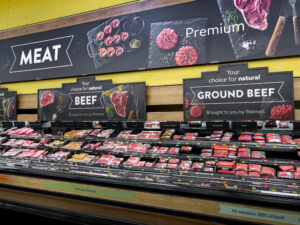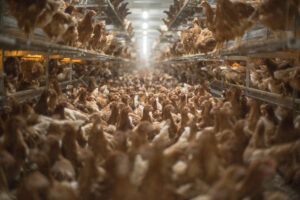Would You Like Sugar and Fat With That?
Tracie McMillan, author of "The American Way of Eating," goes undercover in grocery stores, restaurants and the country's agricultural fields to find out why it's so hard for us to eat healthy food.
“The American Way of Eating: Undercover at Walmart, Applebee’s, Farm Fields and the Dinner Table” A book by Tracie McMillan
Most food writers begin their tales with fond reminiscences of the great grub they grew up with: mom’s Sunday meatballs or the secret recipe for grandma’s beloved Christmas cookies. Tracie McMillan takes the opposite tack. She grew up in a working-class family in Flint, Mich., eating Ortega Taco dinners and salads made with iceberg lettuce and Wish-Bone Ranch dressing. The lesson that her grandmother taught her was that any meal that took time or money to prepare — or, worse, both — was for “fancy” people. Her father called them snobs.
It was only after a decade in New York that McMillan began to question the assumption she had been spoon-fed since childhood. On the poverty beat for a small magazine, she was assigned to cover a cooking class for city youth. There she met Vanessa, a classic “mouthy” Bronx teen who explained that, sure, she ate a lot of fast food. But she’d much prefer to eat broccoli and tomatoes — if they were affordable and easily available in her neighborhood.
That was McMillan’s aha moment. Why, she wondered, is it so difficult for so many Americans to eat well? To find out, she went undercover in a series of unskilled jobs that took her, as she describes it, from farm to plate: She labors as a farmhand in California, picking grapes, sorting peaches and cutting garlic. She stocks shelves at a Walmart in suburban Michigan. She expedites orders at a busy Applebee’s in Brooklyn. And she lives on the paltry wages that she earns to see what culinary compromises she is forced to make. Along the way, she unpacks how these jobs, and the corporate food chain as a whole, have evolved and shape the way we eat. Think of it as the food version of “Nickel and Dimed,” Barbara Ehrenreich’s classic undercover investigation into life in low-wage America.
The American Way of Eating: Undercover at Walmart, Applebee’s, Farm Fields and the Dinner Table
By Tracie McMillan
Scribner, 336 pages
McMillan is a lively storyteller. It’s not easy to create narrative tension while describing repetitive, menial jobs such as unloading pallets of processed foods, but somehow she keeps readers’ attention. “Like any stranger in a foreign land, I’m overwhelmed by the landscape around me,” she writes of her first overnight shift in the grocery department of a Walmart in Kalamazoo. “Finding the Great Value (the Walmart house brand) flour is akin to locating North America on a map, but locating the solitary strip of Great Value Sugar-Free Strawberry Banana Gelatin is more like being tasked with finding the capital of Bhutan.”
More important, her investigation pulls back the curtain on a host of unsavory practices along the food chain. At McMillan’s first stop, in the garlic fields of California’s Salinas Valley, she discovers how companies avoid paying workers the minimum wage. “The problem is that, somewhere between the farm and our paychecks, the company is changing the number of hours for which it is paying us,” she writes, explaining a friend’s paltry earnings. “Even though Rosalinda’s tarjeta will show that she came in at 5:30 a.m. and left at 2:30 p.m., a nine-hour day, her check will say she was there for two hours — exactly the number of hours she would have had to work at minimum wage ($8) to earn what she made via piece rate ($16).” As most workers are illegal, they have no recourse to get their due. To make the equivalent of minimum wage, McMillan notes, a picker would have to be superhuman, plucking half a ton of garlic in eight hours.
|
To see long excerpts from “The American Way of Eating” at Google Books, click here. |
Later, at Walmart, she shows how workers “crisp” limp greens — soaking the leaves in lukewarm water, then plunging them into a cooler — so they appear fresh. (No wonder “fresh” produce rots so fast in the crisper drawer.) At Applebee’s, McMillan is given no food-safety training for her job overseeing the plates that go out to customers. When a corporate inspector arrives, fellow workers prompt her to lie about her training and feed her the answers to technical questions. The inspector is so impressed that she recommends McMillan as a potential manager.
The problem is that her well-written narrative doesn’t help to unravel the mystery McMillan set out to solve at the beginning: Why don’t low-income families eat more fresh and healthy food? Unlike Ehrenreich in “Nickel and Dimed,” McMillan is not content to simply show what life is like on the front lines of the industrial food system. She has set for herself the thorny task of connecting those realities to the larger issue of why people eat cheap and processed food. And that is far more complicated than the tales of abuses in the field, shortcuts at Walmart and mass-produced cuisine at Applebee’s can explain.
These stories do not allow for the many people who simply prefer the end products of our industrial system. If such food is really an abomination, who were all those customers keeping cooks so busy at the Brooklyn Applebee’s? McMillan never ventures out of the kitchen to find out. The low-income families she holds up as models are for the most part first- and second-generation immigrants who brought with them a food culture that values home-cooked food.
The truth is, not everyone who eats fast food is like Vanessa, the Bronx student who sent McMillan on her yearlong quest for answers. Over the last half-century, we have created a food culture in this country that glorifies cheap prices and convenience. (McMillan of all people should know that. It’s what her grandmother told her growing up.) Over time, that emphasis has trained many American palates to appreciate the sugary, salty taste of processed food. Even if workers were paid a fair wage and the produce at Walmart were pristine, there’s no guarantee that more people would buy it.
McMillan does try to connect the dots by stepping back and putting her on-the-ground reporting in historical and economic context. She traces the rise of supermarkets and demonstrates how Walmart came to dominate not only food retail but distribution, too. She argues that, in certain neighborhoods, that can lead to higher, not lower, prices. She explains how and why restaurants now gobble 41 percent of the average family’s food budget, up from just 15 percent in 1940. These passages provide an excellent introduction to the complicated and contentious debate about how to reform America’s food system. But without acknowledging culture, they too cannot satisfactorily explain the “American way of eating.”
The American Way of Eating: Undercover at Walmart, Applebee’s, Farm Fields and the Dinner Table
By Tracie McMillan
Scribner, 336 pages
What McMillan does succeed in showing us is that the choices that Americans make each day about what to eat have far more to do with larger failures in American society than the way our food is produced and distributed. To thrive, workers need a bigger share of corporate profits. Families need health care and subsidized child care. Otherwise, shopping for and preparing a proper meal will always be a luxury.
“So far as I can tell, changing what’s on our plates simply isn’t feasible without changing far more,” she writes in her final pages. “Wages, health care, work hours and kitchen literacy are just as critical to changing our diets as the agriculture we practice or the places at which we shop.” But by the time she reaches that conclusion, her adventure is over. All she can do is close with a wish list of progressive social policies and a call to make eating well easy. Which, as she has proved, is much easier said than done.
Jane Black, a former Washington Post staff writer, is working on a book about a West Virginia town that is trying to create a healthier local food culture.
© 2012, Washington Post Book World Service/Washington Post Writers Group
Your support matters…Independent journalism is under threat and overshadowed by heavily funded mainstream media.
You can help level the playing field. Become a member.
Your tax-deductible contribution keeps us digging beneath the headlines to give you thought-provoking, investigative reporting and analysis that unearths what's really happening- without compromise.
Give today to support our courageous, independent journalists.






You need to be a supporter to comment.
There are currently no responses to this article.
Be the first to respond.